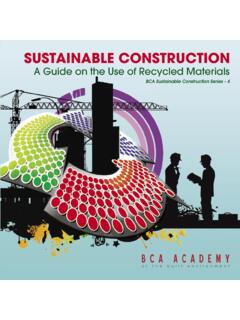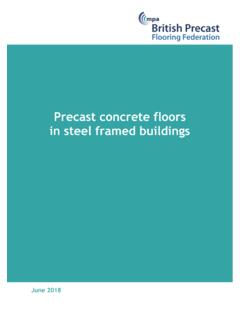Transcription of National Structural Concrete Specifi cation - Home
1 A cement and Concrete industry publication National Structural Concrete Speci cation for Building Construction Fourth edition complying with bs en 13670: 2009. NSCS Standard Specification A technical committee of CONSTRUCT, the Concrete Structures Group, prepared this speci cation as the 4th edition of National Structural Concrete Speci cation for Building Construction, originally published in February 1998. Technical Committee Attending Members Julian Maw (Chairman) CONSTRUCT Charles Goodchild MPA/The Concrete Centre Paul Toplis (Technical Editor) Price & Myers Patrick Hallinan Mace Edwin Bergbaum Waterman Structures Ltd Graham Hardwick John Doyle Construction Gordon Clark Gifford Roger Hewitt Scott Wilson Ltd Andrew Cotter MPA/The Concrete Centre Mike Howard Laing O'Rourke Alistair Craig Carillon Building Deborah Lazarus Arup/Institution of Neil Crook The Concrete Society Structural Engineers Roger Davies Gifford Neil Loudon Highways Agency Richard Day The Concrete Society John Webster BAA Airports Ltd James Fudge British Precast Rob Westcott Alan Baxter & Associates Visiting Specialists Kevin Bennett Freyssinet Ltd.
2 Richard Digman UK CARES. Corresponding Members Rod McClelland CBDG Brian Spencer Southern Water Past Members Clive Budge, Andy Butler, Peter Goring, John Mason CONSTRUCT and the authors thank the numerous organisations from all sections of the industry whose views and comments have been sought and carefully reviewed for inclusion. The work of preparing this speci cation was managed and funded by CONSTRUCT and MPA The Concrete Centre. CCIP-050. First edition published February 1998. This 4th edition published April 2010. ISBN 978-1-904818-96-0. Price Group P. CONSTRUCT 2010. Published by The Concrete Centre, Prepared by CONSTRUCT. part of the Mineral Products Association Riverside House Riverside House 4 Meadows Business Park 4 Meadows Business Park Station Approach, Blackwater, Camberley, Station Approach, Blackwater, Camberley, Surrey GU17 9AB.
3 Surrey GU17 9AB. Tel: +44 (0)1276 606800 Tel: +44 (0)1276 38444. Fax: +44 (0)1276 606801 Fax: +44 (0)1276 38899. All data, information and opinions contained herein aim to re ect accepted practices at the time of publication. While every effort has been made to ensure accuracy, no responsibility can be accepted for errors and omissions, however caused. No responsibility for any loss occasioned as a result of material in the publication is accepted by the authors or publishers. Responsibility for interpretation of the material contained in this publication rests entirely with the user. All rights reserved. No part of this publication may be reproduced, stored in a retrievals system or transmitted in any form or by any means, electronic, mechanical, photocopying, recording or otherwise without the prior permission of CONSTRUCT, except as noted.
4 Front cover image courtesy of The Concrete Centre. Production editor: Gillian Bond, Words & Pages, Hythe, CT21 5LS. Grant Smith Photography Printed by Michael Burbridge Ltd, Maidenhead, UK. 2. Foreword This fourth edition of the National Structural Concrete Speci cation (NSCS) has been completely reviewed and revised to encompass the requirements of the Eurocodes and bs en 13670: 2009, Execution of Concrete structures. It provides a bs en 13670-compliant speci cation for use in Structural Concrete building construction designed to the Eurocodes. The adoption in the UK for the rst time of a workmanship or execution standard in place of the workmanship requirements forming part of a design standard has necessitated some changes to the structure of this document and terminology, but this edition of the NSCS still has the same objective, that is to provide a de nitive, simple and straightforward speci cation without unnecessary constraints.
5 The section on execution management follows the introduction of this term in bs en 13670 and the numbering of the speci cation sections follows that of the standard. bs en 13670 requires the use of an execution speci cation , consisting of documents and drawings to communicate additional and project-speci c construction requirements between Client, Designer and Constructor. The NSCS for Building Construction forms part of the Execution Speci cation , called for in bs en 13670: 2009, and has been designated by its National Annex as Non-Contradictory Complementary Information. The tolerance requirements of bs en 13670 have been drawn up solely to assure Structural safety of the building structure for a Eurocode design and are therefore not always suf cient to ensure reasonable construction coordination with following trades.
6 The NSCS tolerances provide additional requirements aimed at coordination for normal circumstances and con rm the responsibility of different parties for ensuring the issues are carefully considered, where required, to suit the details of a particular project. The NSCS contains three documents: the NSCS Standard Speci cation and NSCS Project Speci cation (which together form the bs en 13670 Project Speci cation ) and NSCS Guidance. The latter provides informative guidance for interpretation and usage of both Speci cations. Clauses in bs en 13670 have been repeated at times for clarity. The NSCS Standard Speci cation gives standards and technical data for use in the UK. The interrelationship of this Speci cation with bs en 13670 and the contract documents is illustrated in Figure A.
7 The NSCS Guidance to execution management describes how NSCS Standard Speci cation , a completed NSCS Project Speci cation , the drawings and other documents taken together provide all the information required to be included in the Execution Speci cation of bs en 13670. The functions of each part are summarised below. The NSCS Standard Speci cation provides a base Speci cation with standard clauses on execution, materials and construction for the production of consistent and well-constructed reinforced Concrete building structures. The NSCS Project Speci cation provides the information and requirements speci c to the project. It records, by exception, any amendments to the Standard Speci cation considered necessary by the designer and is the part of the Speci cation where information is provided by the tenderer.
8 This enables tender documents or the contract for construction to consist of a Project Speci cation only, because it refers explicitly to the Standard Speci cation as its base document. To aid the task of preparing a Project Speci cation , permission is hereby expressly given for users of this document to copy the whole of Project Speci cation without infringement of copyright. A data disc, or download, is available from CONSTRUCT. to enable easy electronic completion and distribution of the Project Speci cation . To aid the task the NSCS Project Speci cation has prompts to encourage speci cations requiring best practice in sustainable i construction and environmental management. It is expected that standards for these issues will be evolving throughout the construction industry over the next few years and so speci ers should be adding their requirements on most projects.
9 The NSCS Guidance is a companion document to the speci cation and gives background information together with explanations of why certain clauses have been adopted. The information is intended to be of use to both the Designer and Constructor. The Guidance does not form part of the Execution Speci cation . The NSCS assumes the Engineer remains responsible for using reasonable skill, care and diligence to design the structure and that the Constructor builds what is shown on the drawings to the speci ed standard. The Constructor is expected to exercise in the performance of his duties all such skill, care and diligence as may be expected of an experienced and competent Constructor used to working on projects of similar size, scope and complexity of Structural Concrete works using appropriately quali ed and experienced staff.
10 Prescriptive restraints have been avoided, so enabling the Constructor's experience to be used for ef cient construction. The NSCS aims to ensure that the speci cation draws together all the day-to-day information needed by the Designers, Contract Administrator (CA) and the Constructor; it therefore includes information which may duplicate provisions in project preliminaries. It is important that, when the NSCS Standard Speci cation is used, all the project team make use of it and should the project preliminaries differ, the NSCS Project Speci cation should indicate the required changes. The bene ts of using NSCS will best be achieved by continuing the collaboration between Contractors, Speci ers and Designers that arose during its development.




